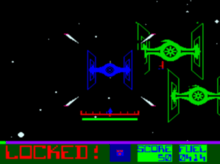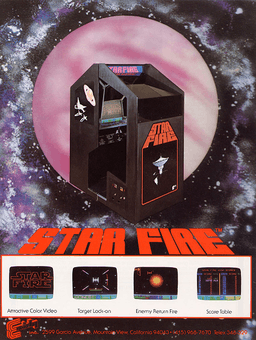Star Fire
| Star Fire | |
|---|---|
|
First alternate arcade flyer of Star Fire. | |
| Developer(s) | Exidy |
| Publisher(s) | Exidy |
| Designer(s) | David Rolfe and Ted Michon |
| Platform(s) | Arcade, Atari 800, Commodore 64 |
| Release date(s) | 1979 |
| Genre(s) | 3d shooter |
| Mode(s) | Single player |
| Cabinet | Upright, Environmental |
| Display | Raster |
Star Fire a first person space shooter arcade game released by Exidy in 1979. It is the first arcade game to use a sit-down cockpit,[1][2] and the first arcade game to allow a player to enter his or her initials into the high score table.[3] Star Fire is in full color—without the use of monitor overlays—which was still unusual in 1979.
The look and feel of Star Fire is directly lifted from the movie Star Wars, though the game is not officially licensed. The attract-mode displays the name Star Fire in the same swooping sans-serif display typeface used by the Star Wars main titles. The enemy spaceships are TIE fighters and the player's primary weapon is an array of 4 lasers that fire in an "X" pattern, implying that the player is flying a ship somewhat akin to an X-wing. The enemy base looks like the Death Star.
Gameplay

The player controls whether his ship is moving forward or backwards via a lever. A control yoke translates the player's view left, right, up, or down. The controls are loose and somewhat floaty; nimble moves are not possible. The player has a button that fires his quad-linked lasers at a targeting reticle. The lasers travel slowly, taking about 2 seconds to reach their target, and only one shot can be in the air at once. Furthermore, each shot the player fires causes heat to build up in his ship. If the player's rate of fire is too high, his guns will overheat and he will need to wait for them to cool down.
If the player can maneuver such that a TIE fighter-like ship is directly in the targeting reticle, he will "lock on" and any shots fired will automatically hit. When the player successfully shoots an enemy TIE fighter lookalike, the screen prints "GOT HIM". Occasionally, a thinner, horizontally oriented ship that looks like a Colonial Viper from Battlestar Galactica will be seen. These have "Exidy" written on their tails, and are worth the largest amount of points. If the player successfully shoots this ship, the screen displays "GOT US". These ships can not be locked onto.
The game is timed and the more money the player puts in, the longer s/he can play. As the player shoots enemy ships, they increase in skill, and also in point value. If the player reaches certain point thresholds, he is given more "fuel" and can thus play longer. The player's ship can be shot; this simply resets the quality of enemies (and thus their point value) down to the lowest level.
Reception
Electronic Games in 1983 called Star Fire a "closet classic ... deserving of a better fate", created "ahead of its time and unable to find a market".[2]
Legacy
Epyx ported Star Fire and another Exidy game, Fire One!, to the Atari 8-bit family and Commodore 64, and released them in 1983 as an arcade classics compilation.[4]
Star Fire can be run on a PC by the Multiple Arcade Machine Emulator. It is one of the few games that has been legally released for use on the MAME emulator, along with its unreleased update, Star Fire II.
The current record for the high score is 9,780 points, set by Laura Curran of Las Vegas in January 1982. As of 2010 this was the oldest high score record in the Twin Galaxies arcade database.[5]
Easter Egg
Entering certain sets of initials into the high score table will cause the game to print certain messages:
- "DBR" → "HI DAVE, I HOPE YOU ARE WELL".
- "SKO" → "HI SUSAN".
- "TZM" → "HI TED. MAY THE FORCE BE WITH YOU".
References
- ↑ "Star Fire". The International Arcade Museum. Retrieved 7 Oct 2013.
- 1 2 Pearl, Rick (June 1983). "Closet Classics". Electronic Games. p. 82. Retrieved 6 January 2015.
- ↑ "High Score"
- ↑ "Atarimania - Arcade Classics: Star Fire / Fire One!". Retrieved 2011-02-01.
- ↑ The Denton Arcade Game Examiner: Longest-standing classic arcade video game record revealed, 03 May 2010
